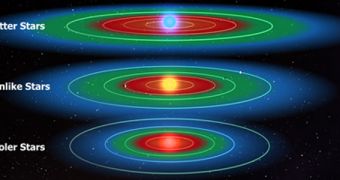According to the conclusions of a new scientific investigation, it would appear that extrasolar moons orbiting alien worlds around binary star systems may have a higher chance of developing into habitable environments than their counterparts orbiting extrasolar planets in single-star systems.
During a presentation held at the 223rd American Astronomical Society meeting in January, researchers from the University of Texas in El Paso, led by astrophysicist Paul Mason, argued that the main reason why this extra “habitability” occurs is that members of a binary star system tend to dampen each other's solar radiations and stellar winds.
This means that planets and moons developing around stellar pairs are less likely to have their atmospheres stripped away by intense solar radiations. This phenomenon can be observed both on Mars and on Earth's Moon, in our own solar system. Binary systems may be among the best suited locations to find alien life, Mason told attendants at the conference.
“The two stars calm each other down in terms of activity,” the expert told Astrobiology Magazine in a recent interview. The results he and his team presented were derived from an analysis of data sent back to Earth by the NASA Kepler planet-hunting telescopes. This mission was launched to discover potentially-habitable exoplanets in a nearby sector of the Milky Way.
Mason added that no exomoons have thus far been accurately identified in Kepler data. This means that all studies of this type are theoretical and meant to provide a statistical and theoretical framework of what astronomers can expect to discover when such objects are indeed found. The NASA observatory has thus far confirmed more than 1,000 exoplanets, with an additional 2,000+ as strong candidates.
The team leader explained that stars in close binary systems tend to synchronize their spin, a phenomenon that enables these objects to dampen each other's radiation emissions. This effect is not found in binaries whose members orbit farther away from each other or in systems made up of violent, active, newly-formed stars.
The habitable zone around a binary star is also much farther away from the objects than the Sun's is. “The habitable zone in a binary system is a little bit farther away, simply because you have the light from two stars rather than the light from one,” Mason explained.
“The closer a planet is to the star, the smaller its gravitational sphere of influence. Essentially, the star will rip off the moon if it gets too close,” added Harvard-Smithsonian Center for Astrophysics astronomer David Kipping in an interview with the Magazine.
Upcoming missions such as the NASA James Webb Space Telescope (JWST) – currently scheduled for launch around 2018 – will undoubtedly be capable of identifying exoplanets and exomoons directly, potentially confirming or infirming this type of studies.

 14 DAY TRIAL //
14 DAY TRIAL //